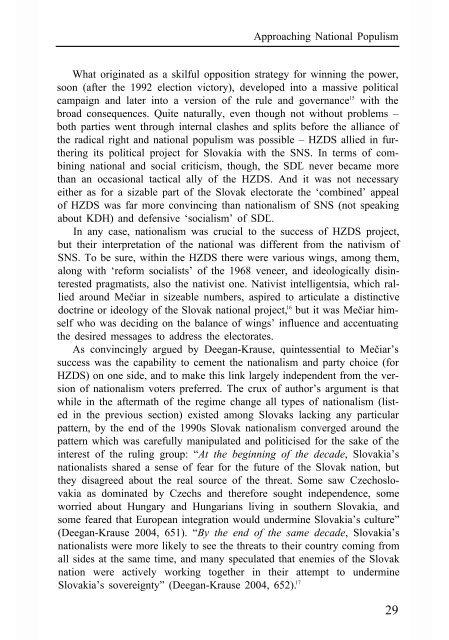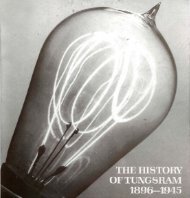national populism and slovak â hungarian relations in - MEK
national populism and slovak â hungarian relations in - MEK
national populism and slovak â hungarian relations in - MEK
Create successful ePaper yourself
Turn your PDF publications into a flip-book with our unique Google optimized e-Paper software.
Approach<strong>in</strong>g National PopulismWhat orig<strong>in</strong>ated as a skilful opposition strategy for w<strong>in</strong>n<strong>in</strong>g the power,soon (after the 1992 election victory), developed <strong>in</strong>to a massive politicalcampaign <strong>and</strong> later <strong>in</strong>to a version of the rule <strong>and</strong> governance 15 with thebroad consequences. Quite naturally, even though not without problems –both parties went through <strong>in</strong>ternal clashes <strong>and</strong> splits before the alliance ofthe radical right <strong>and</strong> <strong>national</strong> <strong>populism</strong> was possible – HZDS allied <strong>in</strong> further<strong>in</strong>gits political project for Slovakia with the SNS. In terms of comb<strong>in</strong><strong>in</strong>g<strong>national</strong> <strong>and</strong> social criticism, though, the SD¼ never became morethan an occasional tactical ally of the HZDS. And it was not necessaryeither as for a sizable part of the Slovak electorate the ‘comb<strong>in</strong>ed’ appealof HZDS was far more conv<strong>in</strong>c<strong>in</strong>g than <strong>national</strong>ism of SNS (not speak<strong>in</strong>gabout KDH) <strong>and</strong> defensive ‘socialism’ of SD¼.In any case, <strong>national</strong>ism was crucial to the success of HZDS project,but their <strong>in</strong>terpretation of the <strong>national</strong> was different from the nativism ofSNS. To be sure, with<strong>in</strong> the HZDS there were various w<strong>in</strong>gs, among them,along with ‘reform socialists’ of the 1968 veneer, <strong>and</strong> ideologically dis<strong>in</strong>terestedpragmatists, also the nativist one. Nativist <strong>in</strong>telligentsia, which ralliedaround Meèiar <strong>in</strong> sizeable numbers, aspired to articulate a dist<strong>in</strong>ctivedoctr<strong>in</strong>e or ideology of the Slovak <strong>national</strong> project, 16 but it was Meèiar himselfwho was decid<strong>in</strong>g on the balance of w<strong>in</strong>gs’ <strong>in</strong>fluence <strong>and</strong> accentuat<strong>in</strong>gthe desired messages to address the electorates.As conv<strong>in</strong>c<strong>in</strong>gly argued by Deegan-Krause, qu<strong>in</strong>tessential to Meèiar’ssuccess was the capability to cement the <strong>national</strong>ism <strong>and</strong> party choice (forHZDS) on one side, <strong>and</strong> to make this l<strong>in</strong>k largely <strong>in</strong>dependent from the versionof <strong>national</strong>ism voters preferred. The crux of author’s argument is thatwhile <strong>in</strong> the aftermath of the regime change all types of <strong>national</strong>ism (listed<strong>in</strong> the previous section) existed among Slovaks lack<strong>in</strong>g any particularpattern, by the end of the 1990s Slovak <strong>national</strong>ism converged around thepattern which was carefully manipulated <strong>and</strong> politicised for the sake of the<strong>in</strong>terest of the rul<strong>in</strong>g group: “At the beg<strong>in</strong>n<strong>in</strong>g of the decade, Slovakia’s<strong>national</strong>ists shared a sense of fear for the future of the Slovak nation, butthey disagreed about the real source of the threat. Some saw Czechoslo -vakia as dom<strong>in</strong>ated by Czechs <strong>and</strong> therefore sought <strong>in</strong>dependence, someworried about Hungary <strong>and</strong> Hungarians liv<strong>in</strong>g <strong>in</strong> southern Slovakia, <strong>and</strong>some feared that European <strong>in</strong>tegration would underm<strong>in</strong>e Slovakia’s culture”(Deegan-Krause 2004, 651). “By the end of the same decade, Slovakia’s<strong>national</strong>ists were more likely to see the threats to their country com<strong>in</strong>g fromall sides at the same time, <strong>and</strong> many speculated that enemies of the Slovaknation were actively work<strong>in</strong>g together <strong>in</strong> their attempt to underm<strong>in</strong>eSlovakia’s sovereignty” (Deegan-Krause 2004, 652). 17National Populism <strong>and</strong> Slovak – Hungarian Relations <strong>in</strong> Slovakia 2006 – 2009. Forum M<strong>in</strong>ority Research Institute Šamorín – Somorja, 200929








![Letöltés egy fájlban [4.3 MB - PDF]](https://img.yumpu.com/50159926/1/180x260/letaltacs-egy-fajlban-43-mb-pdf.jpg?quality=85)







